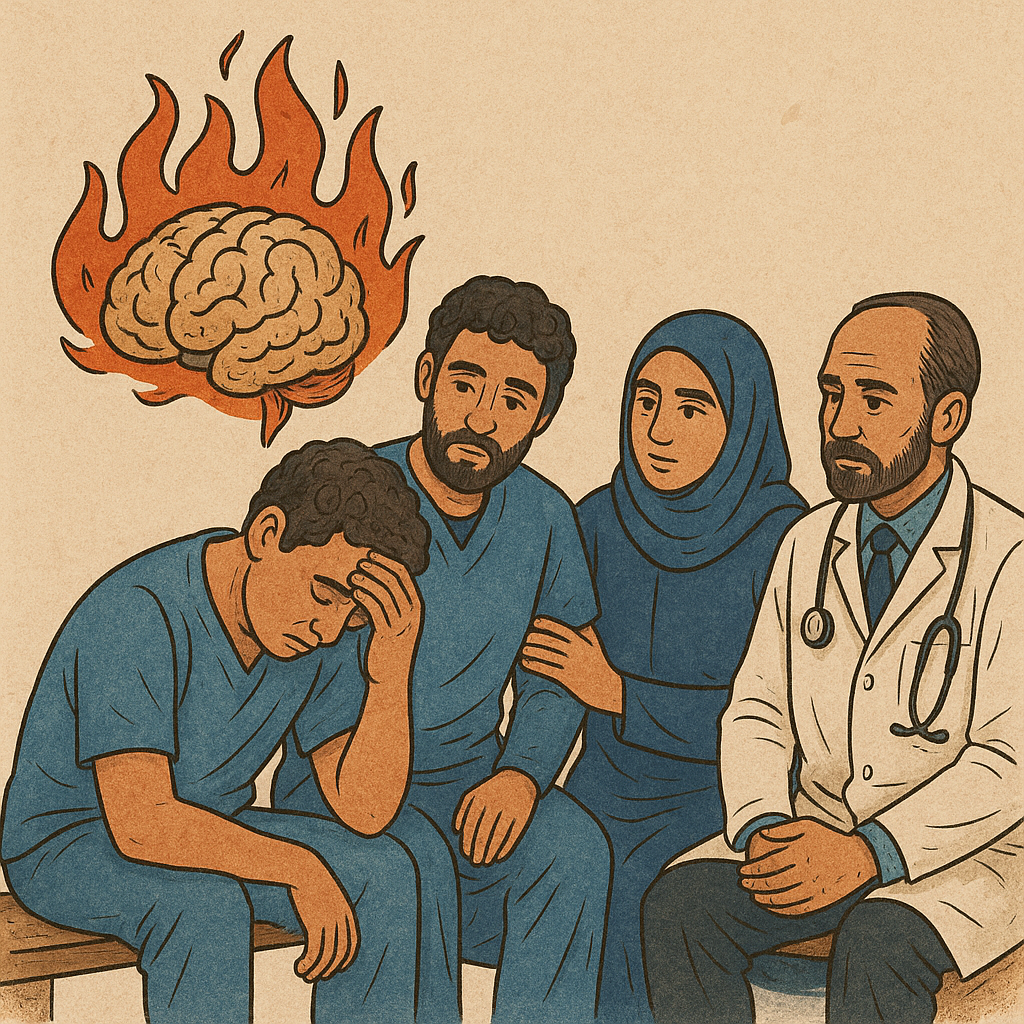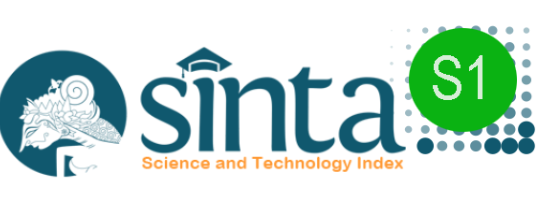Burnout and resilience among moroccan healthcare professionals: a comprehensive multi-hospital study

Downloads
Introduction: This study examines the relationship between burnout and resilience among physicians and caregivers, aiming to determine whether the type of setting and demographic characteristics, such as gender and hospital hierarchy, have any impact.
Methods: This multicenter cross-sectional study recruited 296 healthcare professionals through convenience sampling by self-administered questionnaires evaluating the Maslach Burnout Inventory and Connor-Davidson Resilience Scale. Data were analyzed using statistical methods, including correlation analysis and Multiple Correspondence Analysis (MCA).
Results: From 158 valid responses, the mean scores for each scale were: EE at 28.44±12.90, DP at 9.96±6.47, and PA at 29.01±10.48; resilience was 23.78±7.71. All three had positive correlations with resilience. There were no significant differences in resilience or burnout between men and women. However, EE and PA were significantly correlated with male resilience, while all three burnout dimensions were associated with female resilience. Local hospitals reported higher mean scores for resilience and PA, whereas provincial hospitals exhibited elevated EE and DP scores. In regional hospitals, resilience was only associated with PA, whereas in provincial hospitals, it was correlated with both EE and PA.
Conclusions: We found a high prevalence of burnout and inadequate resilience among healthcare professionals, underscoring the importance of considering these factors in the development of health policies and the implementation of preventive and remedial strategies.
Acosta-Ramos, S. et al. (2021) ‘“Burnout syndrome and association with work stress in nursing staff in public hospital of the northern border of Mexico”’, Archives of Psychiatric Nursing, 35(6), pp. 571–576. doi: 10.1016/j.apnu.2021.07.002.
Albazoon, F. et al. (2023) ‘Burnout among healthcare professionals in Qatar: A systematic review’, Asian Journal of Psychiatry, 85. doi: 10.1016/j.ajp.2023.103601.
American Psychological Association. (2002) Investigating the road to resilience. Available at: https://www.apa.org/monitor/oct02/pp. Accessed on May 2, 2024.
Ardiansyah, R. T. et al. (2019) ‘Factors Affecting Burnout Syndrome Among Nurses: A Systematic Review’, Jurnal Ners, 14(3 Special Issue), pp. 272–276. doi: 10.20473/jn.v14i3.17029.
Artz, B., Kaya, I. and Kaya, O. (2022) ‘Gender role perspectives and job burnout’, Review of Economics of the Household, 20(2), pp. 447–470. doi: 10.1007/s11150-021-09579-2.
Bakhamis, L. et al. (2019) ‘Still an Epidemic: The Burnout Syndrome in Hospital Registered Nurses’, Health Care Manager, 38(1), pp. 3–10. doi: 10.1097/HCM.0000000000000243.
Blackstone, S. R. et al. (2021) ‘Depression, burnout, and professional outcomes among PAs’, Journal of the American Academy of Physician Assistants, 34(9), pp. 35–41. doi: 10.1097/01.JAA.0000769676.27946.56.
Bunga, E. B., Eka, N. G. A. and Hutasoit, E. O. (2020) ‘Relationship between burnout and resilience of nurses at a private hospital in Indonesia’, Enfermeria Clinica, 30, pp. 49–52. doi: 10.1016/j.enfcli.2019.12.025.
Campbell-Sills, L. and Stein, M. B. (2007) ‘Psychometric analysis and refinement of the Connor-Davidson Resilience Scale (CD-RISC): Validation of a 10-item measure of resilience’, Journal of Traumatic Stress, 20(6), pp. 1019–1028. doi: 10.1002/jts.20271.
Chemali, Z. et al. (2019) ‘Burnout among healthcare providers in the complex environment of the Middle East: A systematic review’, BMC Public Health, 19(1). doi: 10.1186/s12889-019-7713-1.
Chen, C. and Meier, S. T. (2021) ‘Burnout and depression in nurses: A systematic review and meta-analysis’, International Journal of Nursing Studies, 124. doi: 10.1016/j.ijnurstu.2021.104099.
Chen, J. et al. (2022) ‘Managing Hospital Employees’ Burnout through Transformational Leadership: The Role of Resilience, Role Clarity, and Intrinsic Motivation’, International Journal of Environmental Research and Public Health, 19(17). doi: 10.3390/ijerph191710941.
Connor, K. M. and Davidson, J. R. T. (2003) ‘Development of a new Resilience scale: The Connor-Davidson Resilience scale (CD-RISC)’, Depression and Anxiety, 18(2), pp. 76–82. doi: 10.1002/da.10113.
Croghan, I. T. et al. (2021) ‘Stress, Resilience, and Coping of Healthcare Workers during the COVID-19 Pandemic’, Journal of Primary Care and Community Health, 12. doi: 10.1177/21501327211008448.
Dall’Ora, C. et al. (2020) ‘Burnout in nursing: A theoretical review’, Human Resources for Health, 18(1). doi: 10.1186/s12960-020-00469-9.
De Hert, S. (2020) ‘Burnout in healthcare workers: Prevalence, impact and preventative strategies’, Local and Regional Anesthesia, 13, pp. 171–183. doi: 10.2147/LRA.S240564.
Dewi, Y. S., Hargono, R. and Rusdi, A. (2019) ‘Factors Correlated to Job Stress Among ICU Nurses’, Jurnal Ners, 14(1), pp. 23–27. doi: 10.20473/jn.v14i1.12125.
Dion, G. and Tessier, R. (1994) ‘Validation of the French-Language Version of the Maslach Burnout Inventory’, Canadian Journal of Behavioural Science-Revue Canadienne Des Sciences Du Comportement, 26(2), pp. 210–227. doi: 10.1037/0008-400X.26.2.210.
Dubale, B. W. et al. (2019) ‘Systematic review of burnout among healthcare providers in sub-Saharan Africa’, BMC Public Health, 19(1). doi: 10.1186/s12889-019-7566-7.
Edú‐valsania, S., Laguía, A. and Moriano, J. A. (2022) ‘Burnout: A Review of Theory and Measurement’, International Journal of Environmental Research and Public Health, 19(3). doi: 10.3390/ijerph19031780.
Fernández-Suárez, I. et al. (2021) ‘Study of the Prevalence of Burnout in University Professors in the Period 2005-2020’, Education Research International, 2021. doi: 10.1155/2021/7810659.
Gök, A. and Koğar, E. Y. (2021) ‘A meta-analysis study on gender differences in psychological resilience levels’, Cyprus Turkish Journal of Psychiatry and Psychology, 3(2), pp. 132–143. doi: 10.35365/ctjpp.21.2.15.
Guo, Y.-F. et al. (2018) ‘Burnout and its association with resilience in nurses: A cross-sectional study’, Journal of Clinical Nursing, 27(1–2), pp. 441–449. doi: 10.1111/jocn.13952.
Hancock, J. et al. (2020) ‘Understanding burnout and moral distress to build resilience: a qualitative study of an interprofessional intensive care unit team’, Canadian Journal of Anesthesia, 67(11), pp. 1541–1548. doi: 10.1007/s12630-020-01789-z.
Hao, S. (2023) ‘Burnout and depression of medical staff: A chain mediating model of resilience and self-esteem’, Journal of Affective Disorders, 325, pp. 633–639. doi: 10.1016/j.jad.2022.12.153.
Hébert, M. et al. (2018) ‘Validation of the French Canadian version of the brief Connor-Davidson resilience scale (CD-RISC 10)’, Canadian Journal of Behavioural Science, 50(1), pp. 9–16. doi: 10.1037/cbs0000092.
Heltty, H. and Zahalim, Z. (2023) ‘Resilience after stroke and its correlation with functional independence’, Jurnal Ners, 18(1), pp. 57–63. doi: 10.20473/jn.v18i1.41229.
Howie-Esquivel, J. et al. (2022) ‘Quality of work-life among advanced practice nurses who manage care for patients with heart failure: The effect of resilience during the Covid-19 pandemic’, Heart and Lung, 55, pp. 34–41. doi: 10.1016/j.hrtlng.2022.04.005.
Hur, G., Cinar, N. and Suzan, O. K. (2022) ‘Impact of COVID-19 pandemic on nurses’ burnout and related factors: A rapid systematic review’, Archives of Psychiatric Nursing, 41, pp. 248–263. doi: 10.1016/j.apnu.2022.09.002.
Jose, S., Dhandapani, M. and Cyriac, M. C. (2020) ‘Burnout and resilience among frontline nurses during covid-19 pandemic: A cross-sectional study in the emergency department of a tertiary care center, north india’, Indian Journal of Critical Care Medicine, 24(11), pp. 1081–1088. doi: 10.5005/jp-journals-10071-23667.
Lee, Y.-R. et al. (2019) ‘A comparative study of burnout, stress, and resilience among emotional workers’, Psychiatry Investigation, 16(9), pp. 686–694. doi: 10.30773/pi.2019.07.10.
Li, L., Liao, X. and Ni, J. (2024) ‘A cross-sectional survey on the relationship between workplace psychological violence and empathy among Chinese nurses: the mediation role of resilience’, BMC Nursing, 23(1). doi: 10.1186/s12912-024-01734-1.
Lian, S.-Y. and Tam, C. L. (2014) ‘Work stress, coping strategies and resilience: A study among working females’, Asian Social Science, 10(12), pp. 41–52. doi: 10.5539/ass.v10n12p41.
Liu, Y. and Cao, Z. (2022) ‘The impact of social support and stress on academic burnout among medical students in online learning: The mediating role of resilience’, Frontiers in Public Health, 10. doi: 10.3389/fpubh.2022.938132.
Maslach, C. (1982) ‘MEASURING BURNOUT WITH THE MBI.’, in. Proceedings - Annual Meeting of the American Institute for Decision Sciences, pp. 183–184.
Maslach, C. and Jackson, S. E. (1981) ‘The measurement of experienced burnout’, Journal of Organizational Behavior, 2(2), pp. 99–113. doi: 10.1002/job.4030020205.
Maslach, C. and Leiter, M. P. (2016) ‘Understanding the burnout experience: Recent research and its implications for psychiatry’, World Psychiatry, 15(2), pp. 103–111. doi: 10.1002/wps.20311.
Maslach, C., Schaufeli, W. B. and Leiter, M. P. (2001) ‘Job burnout’, Annual Review of Psychology, 52, pp. 397–422. doi: 10.1146/annurev.psych.52.1.397.
Morgantini, L. A. et al. (2020) ‘Factors contributing to healthcare professional burnout during the COVID-19 pandemic: A rapid turnaround global survey’, PLoS ONE, 15(9 September). doi: 10.1371/journal.pone.0238217.
Ogus, E. D. (1990) ‘Burnout and social support systems among Ward nurses’, Issues in Mental Health Nursing, 11(3), pp. 267–281. doi: 10.3109/01612849009014560.
Purvanova, R. K. and Muros, J. P. (2010) ‘Gender differences in burnout: A meta-analysis’, Journal of Vocational Behavior, 77(2), pp. 168–185. doi: 10.1016/j.jvb.2010.04.006.
Rink, L. C. et al. (2022) ‘The Association between Well-being Behaviors and Resilience in Health Care Workers’, Western Journal of Nursing Research, 44(8), pp. 743–754. doi: 10.1177/01939459211017515.
Rotenstein, L. S. et al. (2018) ‘Prevalence of burnout among physicians a systematic review’, JAMA - Journal of the American Medical Association, 320(11), pp. 1131–1150. doi: 10.1001/jama.2018.12777.
Rushton, C. H. et al. (2015) ‘Burnout and resilience among nurses practicing in high-intensity settings’, American Journal of Critical Care, 24(5), pp. 412–420. doi: 10.4037/ajcc2015291.
Sisto, A. et al. (2019) ‘Towards a transversal definition of psychological resilience: A literature review’, Medicina (Lithuania), 55(11). doi: 10.3390/medicina55110745.
Southwick, S. M. et al. (2014) ‘Resilience definitions, theory, and challenges: Interdisciplinary perspectives’, European Journal of Psychotraumatology, 5. doi: 10.3402/ejpt.v5.25338.
Truchot, D., Bantégnie, D. and Roncari, N. (2004) ‘Decision making among gps: The impact of burnout and compliance of the patient’, Psychology and Health, 19(SUPPL. 1), pp. 171–172.
Tusaie, K. and Dyer, J. (2004) ‘Resilience: A historical review of the construct’, Holistic Nursing Practice, 18(1), pp. 3–10. doi: 10.1097/00004650-200401000-00002.
Vercio, C. et al. (2021) ‘Shifting Focus from Burnout and Wellness toward Individual and Organizational Resilience’, Teaching and Learning in Medicine, 33(5), pp. 568–576. doi: 10.1080/10401334.2021.1879651.
Wang, L. et al. (2020) ‘The effect of nurse staffing on patient-safety outcomes: A cross-sectional survey’, Journal of Nursing Management, 28(7), pp. 1758–1766. doi: 10.1111/jonm.13138.
Wang, Q., Sun, W. and Wu, H. (2022) ‘Associations between academic burnout, resilience and life satisfaction among medical students: a three-wave longitudinal study’, BMC Medical Education, 22(1). doi: 10.1186/s12909-022-03326-6.
World Health Organization. (2016) Global Strategic Directions for Strengthening Nursing and Midwifery. Available at: https://www.who.int/publications-detail-redirect/9789241510455. Accessed on May 2,2024.
Yin, C. et al. (2023) ‘Impact of long working hours on depressive symptoms among COVID-19 frontline medical staff: The mediation of job burnout and the moderation of family and organizational support’, Frontiers in Psychology, 14. doi: 10.3389/fpsyg.2023.1084329.
Copyright (c) 2025 Jurnal Ners

This work is licensed under a Creative Commons Attribution 4.0 International License.
Authors who publish with Jurnal Ners agree to the following terms:
- Authors transfer the Copyright and grant Jurnal Ners the right of first publication with the work simultaneously licensed under a Creative Commons Attribution 4.0 International License that allows others to remix, adapt and build upon the work with an acknowledgment of the work's authorship and of the initial publication in Jurnal Ners.
- Authors are permitted to copy and redistribute the journal's published version of the work (e.g., post it to an institutional repository or publish it in a book), with an acknowledgment of its initial publication in Jurnal Ners.
Jurnal Ners requires a formal written declaration and transfer of copyright from the author(s) for each article published. We, therefore, ask you to complete and return this form, retaining a copy for your own records. Your cooperation is essential and appreciated. Any delay will result in a delay in publication. The form can be downloaded HERE.































